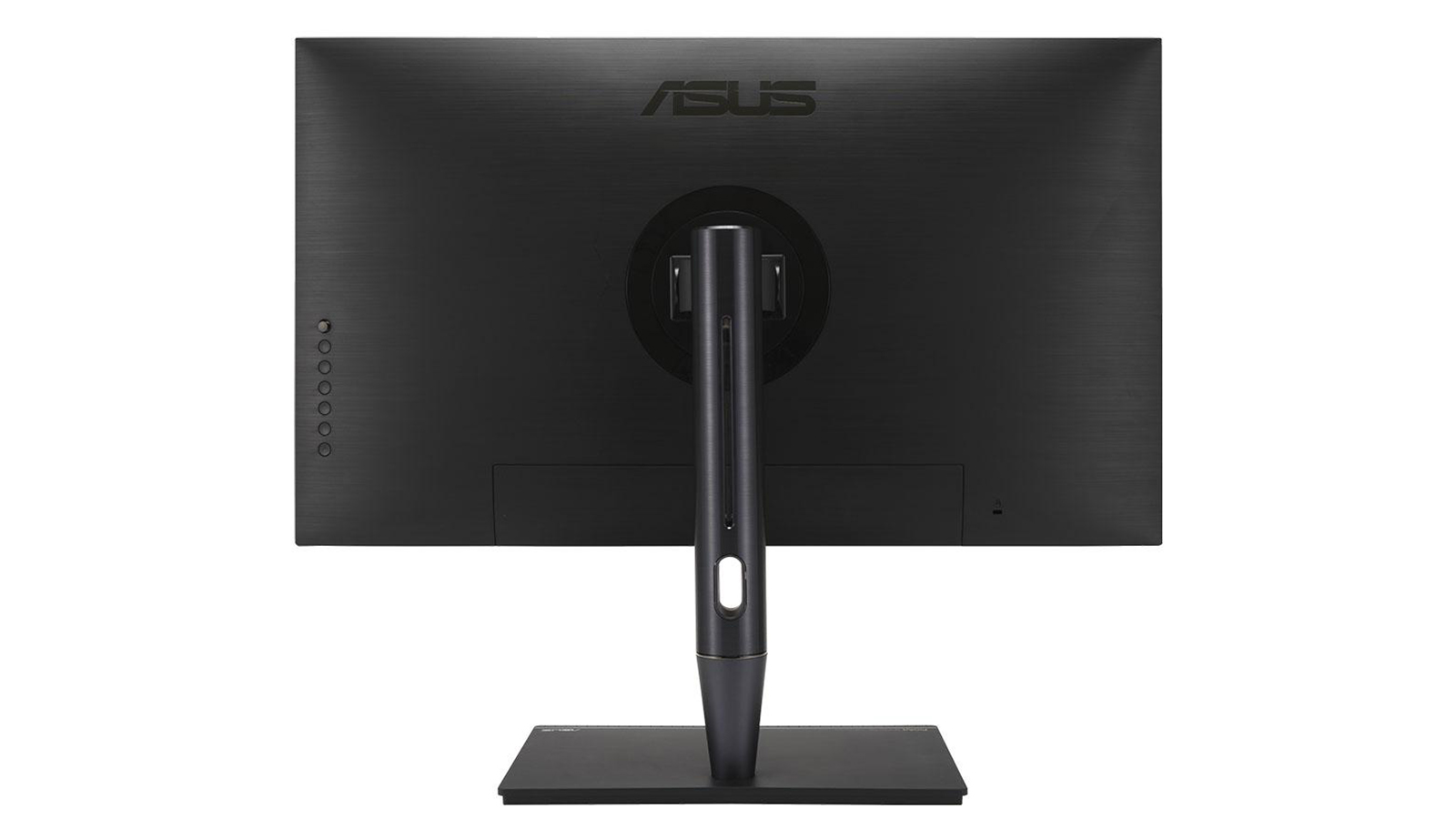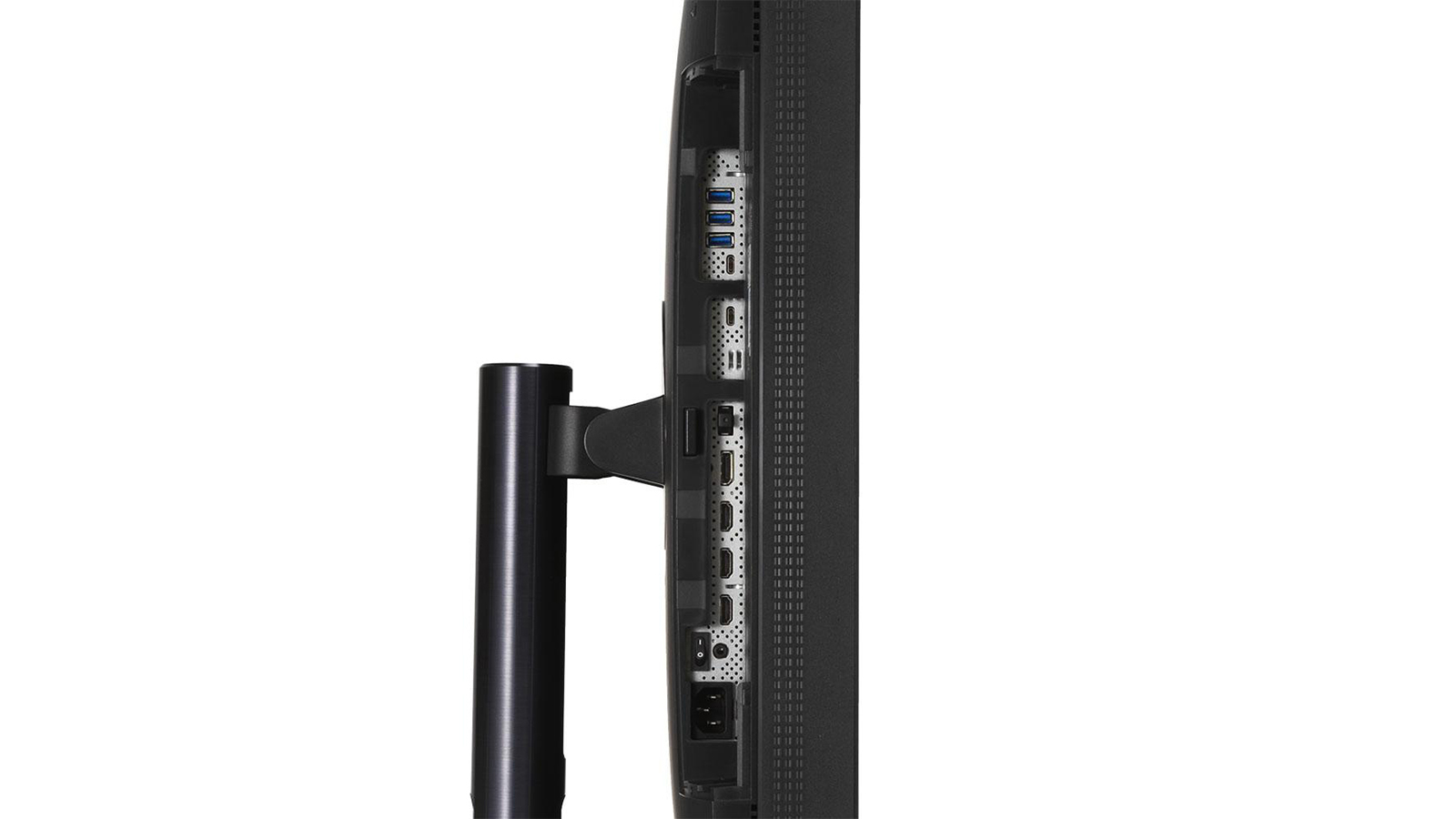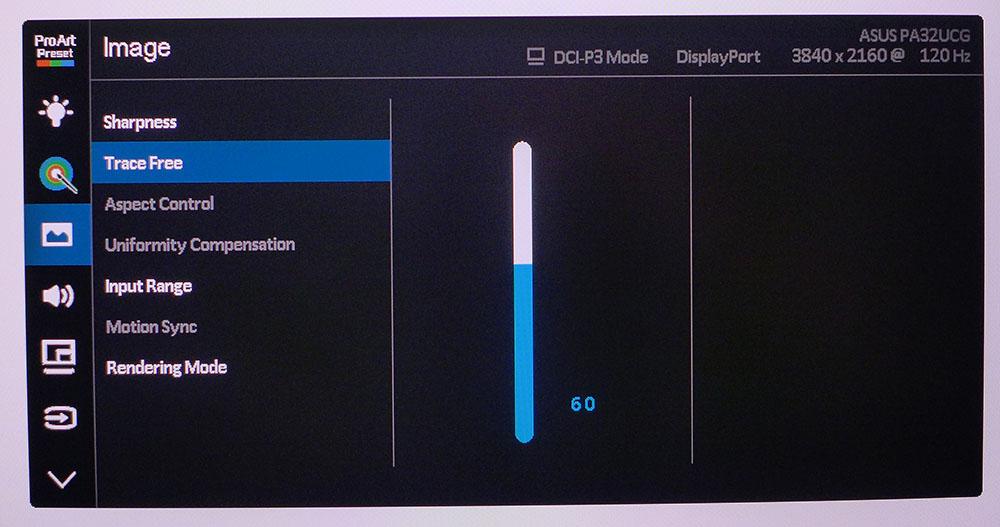Tom's Hardware Verdict
The Asus ProArt PA32UCG is extreme in every respect, including its $5,000 price tag. With near-perfect out-of-box accuracy, record setting brightness and contrast, and supreme versatility, it’s a great solution for professionals and gamers seeking the ultimate display.
Pros
- +
+ Phenomenal image quality in all respects
- +
+ Accurate out of the box in all color modes
- +
+ Supports every gamut, grayscale and gamma standard
- +
+ Dolby Vision support (with September 2021 firmware update)
- +
+ Includes light hood and color meter
- +
+ Solid build quality
Cons
- -
Only 120 Hz
- -
Expensive
- -
Dolby Vision not enabled in early samples
Why you can trust Tom's Hardware
Like all computer components, monitors are designed to fulfill specific roles and perform particular tasks. Gamers need a responsive panel with a rugged build, good contrast and accurate color. Professionals need pinpoint accuracy and versatility. Rarely can one monitor serve equally well as a pro screen and a gaming tool.
If you’re prepared to spend $5,000 on a computer monitor, the Asus ProArt PA32UCG is that display. Not only does it compete effectively with the best gaming monitors, but it also serves as a reference tool for professionals in need of multiple color gamut modes, support for every HDR format, and perfect accuracy right out of the box. It also adds the latest bleeding-edge technology with 1600 nits peak output, near-total coverage of Rec.2020 and a Mini-LED backlight with 1152 dimming zones. Let’s take a look.
Asus PA32UCG Specs
| Panel Type / Backlight | IPS / Full-Array Mini-LED |
| Row 1 - Cell 0 | Quantum Dot Film |
| Row 2 - Cell 0 | 1152 dimming zones |
| Screen Size / Aspect Ratio | 32 inches / 16:9 |
| Max Resolution & Refresh Rate | 3840x2160 @ 120 Hz |
| Row 5 - Cell 0 | 144 Hz over DisplayPort |
| Row 6 - Cell 0 | FreeSync: 48-120 Hz |
| Row 7 - Cell 0 | G-Sync Compatible |
| Native Color Depth & Gamut | 10-bit / Rec.2020 |
| Row 9 - Cell 0 | HDR10, HLG, Dolby Vision |
| Row 10 - Cell 0 | DisplayHDR 1600 |
| Response Time (GTG) | 5ms |
| Brightness (actual) | 440 nits SDR |
| Row 13 - Cell 0 | 1700 nits HDR |
| Contrast (actual) | 1,400:1 native |
| Speakers | 2x 3w |
| Video Inputs | 1x DisplayPort 1.4 |
| Row 17 - Cell 0 | 1x HDMI 2.1 |
| Row 18 - Cell 0 | 2x HDMI 2.0 |
| Row 19 - Cell 0 | 1x Thunderbolt |
| Audio | 3.5mm headphone output |
| USB 3.1 | 1x up, 3x down |
| Row 22 - Cell 0 | 1x USB-C |
| Power Consumption | 51.7w, brightness @ 200 nits |
| Panel Dimensions WxHxD w/base | 28.6 x 18.5-23.6 x 9.4 inches (727 x 470-600 x 240mm) |
| Panel Thickness | 3.7 inches (93mm) |
| Bezel Width | Top/sides: 0.3 inch (8mm) |
| Row 27 - Cell 0 | Bottom: 0.7 inch (19mm) |
| Weight | 32.1 pounds (14.6kg) |
| Warranty | 3 years |
Asus has literally taken every innovation in LCD display technology and packed it into the Asus ProArt PA32UCG’s chunky chassis. This is nearly the same panel we saw in our reviews of the PA32UCX and the PG32UQX. It has a Mini-LED backlight with 1152 dimming zones; almost triple the number of a typical Full Array Local Dimming (FALD) monitor. The color gamut is extended with a Quantum Dot film that delivers almost 78% of the Rec.2020 color space and nearly 100% of DCI-P3. It also covers every gamut from Rec.709 to Adobe RGB with pinpoint accuracy. Peak HDR output is 1600 nits, and, in our tests, we measured over 1700 nits from a full white field pattern. It’s the brightest monitor we’ve ever tested.
Though calibration is not required in any of the gamut modes, Asus has included extensive OSD controls for gamma, color temp and gamut. The PA32UCG also includes an i1 Display Pro color meter which can interface with Asus’ calibration software or Portrait Displays’ Calman. A rigid light-blocking hood comes in the box ready to ensure even better image quality for gamers and professional video editors alike.
Lest you think this is simply a rehash of the PA32UCX, let us set the record straight. The Asus ProArt PA32UCG combines the professional features of the UCX with the gaming cred of the PG32UQX. That means it serves in equal capacity as a reference display and a gaming monitor.
The published refresh rate is 120 Hz at Ultra HD (3840x2160) resolution. But we discovered that over DisplayPort, in a special Rendering Mode, it will run at 144 Hz if you turn off HDR. This equals the top speed currently available in UHD monitors. Of course, Adaptive-Sync is supported on Nvidia and AMD platforms. The PA32UCG has not been certified by Nvidia. The panel has a native 10-bit color depth, and it covers HDR10 and HLG signal formats. It is also slated to support Dolby Vision with a firmware update coming in September, or around the time you’re reading this. At this time, very few computer monitors support Dolby Vision. Though it is not common in games, it is seen in a lot of Ultra HD Blu-ray and streamed content. A professional screen should not be without it.
The Asus ProArt PA32UCG’s price will certainly become a talking point. As of this writing, it sells for $5,000. That is certainly a lot for a gaming monitor but in professional circles, it’s something of a bargain. One could easily spend $13,000 on a 32-inch Sony studio monitor and get none of the Asus’ gaming features. This is a top-of-the-line product that puts everything in a single package. If content creation is your game, the PA32UCG aims to be your go-to tool.
Get Tom's Hardware's best news and in-depth reviews, straight to your inbox.
Assembly and Accessories of the Asus ProArt PA32UCG
Our Asus ProArt PA32UCG sample arrived in an oversized carton with a large bundle of accessories. In addition to a rigid screen hood, we got an i1 Display color meter. This can interface with Asus ProArt software or Calman for both display calibration and ambient light measurement.
The light hood bolts to the panel over the top and sides and is 8.5 inches deep. Blocking out reflections like this helps to increase perceived contrast and improves color vibrancy and saturation. The panel snaps onto a very solid and heavy stand. A full packet of calibration data sheets comes with every PA32UCG showing gamut, grayscale and gamma measurements along with screen uniformity. Every monitor is individually adjusted and verified. Cables include HDMI, DisplayPort, Thunderbolt and USB. An IEC power cord feeds the internal power supply.
Product 360: Asus ProArt PA32UCG




The PA32UCG is styled with function foremost. The panel is almost four inches thick and sits on a stand that’s heavier than most monitors. The front layer reduces the effects of reflected light and is further aided by the light-blocking hood which includes convenient holes for the color meter’s wire. The bezel is relatively thin at 8mm around the top and sides and 19mm on the bottom. On top is a tiny room light sensor that can adjust brightness according to ambient conditions. It’s controlled from the OSD and can be shut off if desired.
The stand is more than able to support the panel’s weight with an upright made from a metal tube that tapers gently into a large base. Only a major earthquake could upset the PA32UCG. It’s not going anywhere. Adjustments are smooth and firm with no play. You get -5/23 degrees tilt, 60 degrees swivel to either side, a 90-degree portrait mode and 5.1 inches of height range.
The input panel is packed with all the latest interfaces. There are three HDMI ports, one of which is version 2.1 that supports 120 Hz signals up to 3840x2160 with HDR. A single DisplayPort supports version 1.4 with Display Stream Compression. A Thunderbolt 3 port is also included for Mac users. USB is covered by a type-C upstream and three v3.1 downstream ports. Headphone users can plug into a 3.5mm audio jack. Once you’ve made your connections, a cover snaps on to hide the wires.
OSD Features on Asus ProArt PA32UCG
The PA32UCG’s OSD is enormous as one would expect from a monitor like this. It’s divided into nine sub-menus that cover all aspects of calibration and gaming performance. Control is via joystick and five keys found around the back right of the panel. Pressing any key brings up a quick menu with access to input selection, quick fit, brightness and HDR modes.








There are 14 picture modes in total, seven for SDR, five HDR and two user memories. Nearly all allow full access to calibration controls and can be individually adjusted. The HDR modes can be engaged with SDR signals to provide a simulation if desired. HDR10 and HLG modes allow either Rec.2020 or DCI-P3 gamuts to be selected. This is helpful for content creation, so the user knows up front what the color reference is.
In the ProArt Palette menu, you’ll find luminance controls along with overall color saturation and hue sliders. Color temp is set by Kelvin value and each label is spot on. Set 6500K and you get 6500K. The same is true of the gamma presets. They range from 1.8 to 2.6. A separate color submenu offers individual color saturation and hue sliders as well as gain and offset controls for color temperature. Though these controls are all very precise, we quickly discovered that the PA32UCG was nearly perfect right out of the box.
The Image and System Setup menus have a range of gaming and video processing options available. Trace Free is Asus’ term for overdrive and it has five settings. 60 does a good job of reducing motion blur without ghosting. Uniformity Compensation is included but we found no need for it. Our PA32UCG sample broke our test record with the feature turned off. Also included is a special Rendering Mode which allows for 144 Hz operation over DisplayPort. The only caveat is that you can’t use HDR with it. For HDR signals, the monitor tops out at 120 Hz. Rendering mode also grays out the extra gamut modes. The monitor only runs in Standard mode which covers around 95% of DCI-P3.
In System Setup, you’ll find the Adaptive-Sync toggle along with an FPS counter and Dynamic Dimming, the controls for the PA32UCG’s FALD backlight. It has three speeds which vary the response to changes in overall picture brightness. Fast worked well in our tests to increase contrast without any image pumping or flickering. We used it for both SDR and HDR content and observed no downsides. Highlight and shadow detail was always crisp and legible.
Calibration Settings on Asus ProArt PA32UCG
After measuring every gamut mode, we concluded that our Asus ProArt PA32UCG sample could not be improved by a manual calibration. Setting it up then becomes a matter of selecting the desired combination of color gamut, color temperature and gamma. The sRGB mode grays out nearly all image adjustments so we picked Rec.709 for SDR content instead. With the 6500K color temp and 2.2 gamma options, it rendered that material perfectly.
DCI-P3 mode defaults to a theater option which includes a very green color temp and a 2.6 gamma. This is fine for film production but for gaming, it’s better to choose 6500K and 2.2. Photographers will enjoy a perfectly accurate Adobe RGB mode. If you want maximum color, Rec.2020 mode covers about 78% of that gamut. In all cases, color temp and gamma are visually perfect. Below, we’ve indicated the brightness settings for commonly used white levels.
| Picture Mode | DCI-P3, Rec.709, Rec.2020, Adobe RGB |
| Brightness 200 nits | 69 |
| Brightness 120 nits | 59 |
| Brightness 100 nits | 56 |
| Brightness 80 nits | 64 |
| Brightness 50 nits | 50 (minimum 9 nits) |
Gaming, Video and Hands-on
The PA32UCG is built to excel at all tasks, both work and play. With modes for every signal type, it can play the latest games, show cutting edge video content and serve as a jack-of-all-trades monitor for film post production, game creation and photo editing. In practice, it leaves almost nothing on the table.
We verified the accuracy of the Rec.709, DCI-P3, Adobe RGB and Rec.2020 modes before spending some time playing games, browsing the web, watching video and working on graphics. No calibration was necessary, but we found the DCI-P3 mode was set up by default to a theater configuration which meant a 6300K white point and 2.6 gamma. Since we weren’t planning to work on any Hollywood CGI for the next Avengers release, we changed to a 6500K color temp and 2.2 gamma. This turned out to be a good all-around picture mode with bold color, solid contrast and a sharp image. Contrast was boosted by the Dynamic Dimming feature which we set to Fast.
Windows apps work best in SDR mode unless HDR is called for in a content creation scenario. We tried out the HDR simulation mode which does a passable job at faking HDR with SDR content. How it looks depends on the material you’re viewing. Some videos were enhanced, and some looked too garish and overblown. It’s an easy switch in the OSD if you want to try it. Beware though, the default brightness setting is the maximum and it is painfully bright. 1600 nits is no joke, if enough white is on the screen, your eyes will hurt. Luckily, you can set the peak to 1000, 600 or 300 nits with the Brightness slider.
Gaming is a joy with the Asus ProArt PA32UCG. Though it costs a lot, it is one of the finest Ultra HD gaming monitors we’ve played on. Your money is buying one of the best-looking screens available. SDR titles like Tomb Raider look rich and saturated when played in DCI-P3 mode. If you want perfectly-accurate color for SDR, choose Rec.709. Contrast with Dynamic Dimming engaged is superb, on par with an OLED panel. Mini-LED is a very effective technology for increasing dynamic range.
The PA32UCG is at its best with HDR games like Doom Eternal and Call of Duty WWII. Both games have their own adjustments for white and black point and overall brightness. Doom’s defaults are just fine, but we had to tweak Call of Duty for the best picture. The result is worth the effort. Color is a level above every other monitor we’ve reviewed. The positive impact of perfect accuracy and full gamut coverage cannot be overstated. And the deep HDR contrast is another element that puts this monitor in a class by itself or, more accurately, in a class with the PG32UQX which is nearly identical to this monitor.
Video processing was never an issue. Adaptive-Sync worked perfectly on both Nvidia and AMD platforms and always delivered a rock-solid 120 fps with G-Sync. That’s no small feat for a PC so you’ll need something like our GeForce RTX 3090 to achieve this. The Radeon RX 5700 XT in our FreeSync test machine kept the action at around 100 fps. It is possible to play at 144 Hz in Rendering Mode over DisplayPort, but we didn’t want to give up HDR.
To really give the PA32UCG an HDR workout, we ran our Spears & Munsil Ultra HD Benchmark demo video from a Panasonic DP-UB9000 Ultra HD Blu-ray player. When compared to any other LCD panel we’ve reviewed except the PA32UCX and the PG32UQX, HDR playback is more than a little above the rest. Only a premium OLED panel can approach the contrast, black levels and color saturation we observed. Highlight areas were incredibly bright, never harsh, and filled with detail. Shadows were a deep black and rich with fine shades. The 1152-zone Mini-LED backlight coupled with peaks of over 1700 nits made for a stunning image.
The PA32UCG is one of the only FALD monitors we’ve seen that doesn’t show any halo artifacts. The demo clips included several pictures of brightly lit objects against inky black backgrounds. The transition between light and dark was perfect.
We were glad to see the PA32UCG’s support for different video frame rates. Content played correctly at 24p, 50p and 60p. Many computer monitors fail to get this right, but Asus has done its homework here. Matching video frame rates is a must for any professional screen.
Current page: Features and Specifications
Next Page Response, Input Lag, Viewing Angles and Uniformity
Christian Eberle is a Contributing Editor for Tom's Hardware US. He's a veteran reviewer of A/V equipment, specializing in monitors. Christian began his obsession with tech when he built his first PC in 1991, a 286 running DOS 3.0 at a blazing 12MHz. In 2006, he undertook training from the Imaging Science Foundation in video calibration and testing and thus started a passion for precise imaging that persists to this day. He is also a professional musician with a degree from the New England Conservatory as a classical bassoonist which he used to good effect as a performer with the West Point Army Band from 1987 to 2013. He enjoys watching movies and listening to high-end audio in his custom-built home theater and can be seen riding trails near his home on a race-ready ICE VTX recumbent trike. Christian enjoys the endless summer in Florida where he lives with his wife and Chihuahua and plays with orchestras around the state.